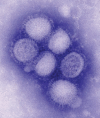H1N1 Influenza in Pregnancy: What All Obstetric Care Providers Ought to Know
- PMID: 19826571
- PMCID: PMC2760905
H1N1 Influenza in Pregnancy: What All Obstetric Care Providers Ought to Know
Abstract
Pregnant women and their fetuses are at high risk of infection with the novel H1N1 influenza A virus. Obstetric providers need to be prepared to provide the care necessary to address the increased morbidity, mortality, and pregnancy-related complications (including spontaneous miscarriage and preterm birth) faced by pregnant women during an influenza pandemic. This article reviews the epidemiology, pathogenesis, clinical manifestations, diagnosis, treatment, and prevention strategies for the current H1N1 influenza pandemic.
Keywords: Clinical manifestation of H1N1 infection in pregnancy; H1N1 complications in pregnancy; H1N1 influenza A.
Figures



References
-
- Dawood FS, Jain S, Finelli L, et al. Novel Swine-Origin Influenza A (H1N1) Virus Investigation Team, authors. Emergence of a novel swine-origin influenza A (H1N1) virus in humans. N Engl J Med. 2009;360:2605–2615. - PubMed
-
- Centers for Disease Control and Prevention Web site, authors. Pregnant women and novel influenza A (H1N1): considerations for clinicians. [Accessed August 24, 2009]. http://www.cdc.gov/h1n1flu/clinician_pregnant.htm. Updated June 30, 2009.
-
- Centers for Disease Control and Prevention (CDC), authors Novel influenza A (H1N1) virus infections in three pregnant women-United States, April–May 2009. MMWR Morb Mortal Wkly Rep. 2009;58:497–500. - PubMed
-
- Centers for Disease Control and Prevention Web site, authors. Considerations regarding novel H1N1 flu virus in obstetric settings. [Accessed August 24, 2009]. http://www.cdc.gov/h1n1flu/guidance/obstetric.htm. Updated July 6, 2009.
-
- Jamieson DJ, Honein MA, Rasmussen SA, et al. Novel Influenza A (H1N1) Pregnancy Working Group, authors. H1N1 2009 influenza virus infection during pregnancy in the USA. Lancet. 2009;374:451–458. - PubMed
LinkOut - more resources
Full Text Sources
